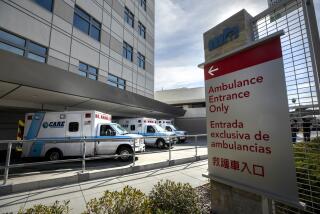Ensign Group is taking care of revenue growth
- Share via
As the U.S. population ages, so does the need to care for the sick and disabled.
That’s what the Ensign Group Inc. in Mission Viejo is banking on. The company provides skilled nursing and rehabilitative care services at 119 facilities in 11 Western states. Thirty-five of those facilities are in California.
The company also operates seven hospice companies, five urgent care clinics and nine home healthcare agencies.
Ensign’s business model is fairly simple: It acquires convalescent hospitals that typically provided long-term care for ill or infirm patients, and converts them to skilled-nursing centers that provide short-term care for people leaving the hospital but not quite well enough to go home.
Skilled-nursing care costs more than convalescent care, increasing Ensign’s per-bed revenue. Skilled-nursing centers typically charge $300 to $600 a day, with stays lasting from two to six weeks, said Greg Stapley, the company’s executive vice president. Convalescent hospitals charge about $175 a day, with stays lasting 18 to 30 months, Stapley said.
“We’re reaching out to people who are in their 60s and have had their first knee or hip replacement, their first heart attack or stroke. They’re not quite sick enough to stay at the hospital but are too sick to go home,” Stapley said.
Skilled-nursing care is attractive to insurers because it’s a cheaper alternative to hospitals.
“When you compare what we do to what’s done in the hospital, skilled nursing is the low-cost alternative,” Stapley said. “I think skilled nursing is going to be very relative over the next couple of decades.”
Ensign was founded in 1999 by “a small group of industry veterans” who sought to transform skilled nursing by hiring people with business backgrounds to manage nursing centers.
Nearly 100% of the company’s facilities are profitable, Stapley said.
The latest
Since 2007, Ensign has nearly doubled the number of nursing and rehabilitative care centers it owns. This year, it acquired facilities in Washington, Nebraska and Texas; assisted living centers in Santa Maria, Calif., and Utah; and hospice centers in Arizona and California.
The acquisitions will help drive revenue, along with additional sales from converting beds from a long-term convalescent model to a short-stay rehabilitation model, Stapley said.
“That will increase your top line a lot,” Stapley said. “You can also increase your top line by filling more of your beds.”
Accomplishments
Ensign’s revenue exploded to $825 million last year from $469 million in 2008. The company’s stock price has more than doubled to more than $30 in less than six years.
“We believe that the skilled nursing industry in general, and Ensign in particular, will be central to the solution of rising healthcare costs,” Ensign’s chief executive, Christopher R. Christensen, said in a recent letter to shareholders. “Whatever the future holds, Ensign has always been ... nimble so that we can quickly respond to any changes in the healthcare landscape.”
Challenges
In late 2011, the U.S. government reduced the amount Medicare would pay skilled nursing centers 11.1%, taking a serious bite out of Ensign’s revenue stream.
Nonetheless, Ensign reported record sales in 2012. Revenue for the year came in at $825 million, a nearly 9% increase from 2011.
About 70% of the company’s revenue comes from government funding: Medicare, Medicaid and the Department of Veterans Affairs.
“The way we’re built, we’re much more nimble and able to respond to those changes than your average top-down organization. We proved that in 2012,” Stapley said. “How do you cover an 11% decrease when you’re operating on a 5% margin? We were one company that actually grew through those head winds and came out better off than when we came in.”
Analyst views
Seven analysts recommend buying the stock, three suggest holding it and none are advising investors sell. They estimate the stock will be trading at $40.20 a share in 12 months, or 12% higher than its Friday close of $35.90.
More to Read
Inside the business of entertainment
The Wide Shot brings you news, analysis and insights on everything from streaming wars to production — and what it all means for the future.
You may occasionally receive promotional content from the Los Angeles Times.











